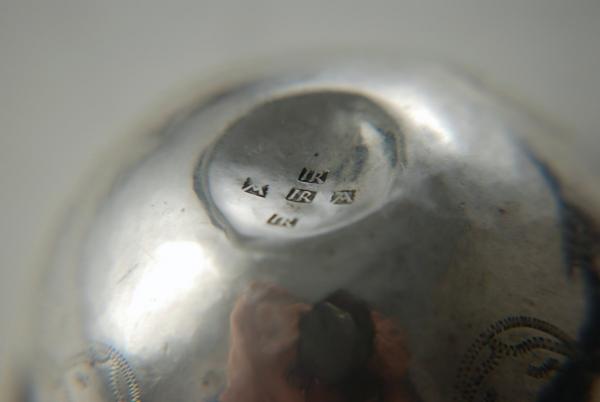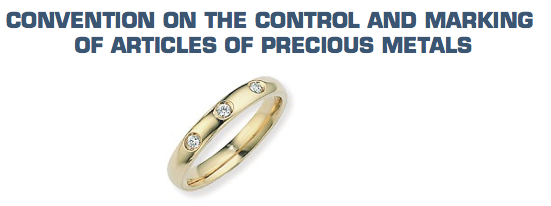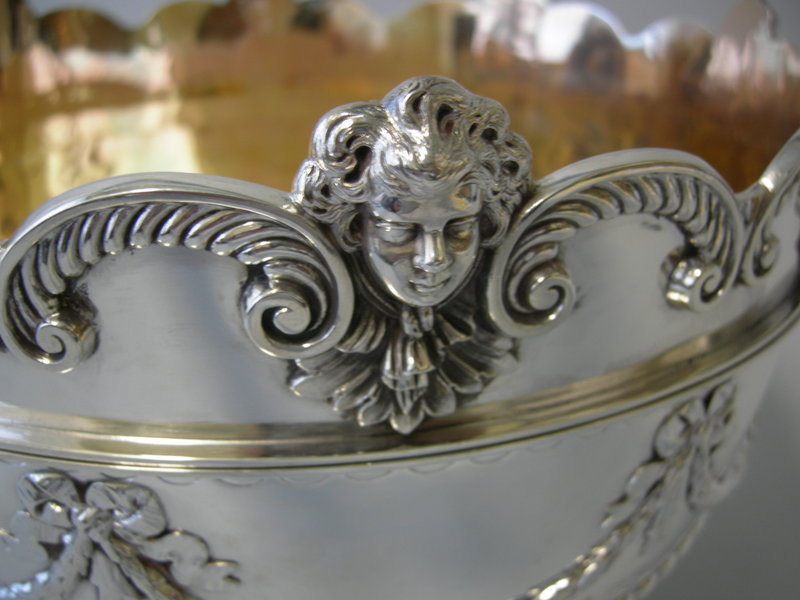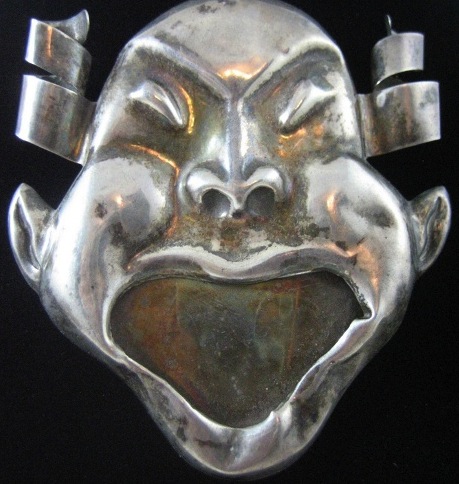Acanthus – A Mediterranean plant having large spiny leaves. Stylized designs of its leaf have been popular in silver work since the classical era.
![]()
Alloy – A mixture of two or more metals accomplished in a molten state. Alloys are formulated to increase desired properties. Fine silver (.999) is too soft and subject to wear to be of utility, it is alloyed with small amounts copper and other metals too increase its hardness and durability.
Alpacca – The trade name of a white colored alloy of roughly 60% copper, 20% nickel, 20% zinc, and 5% tin, it contains no silver and is primarily used as a base metal for silverplating. First formulated in Germany in the 19th century by the chemists Henninger and Geitner. Sometimes spelled Alpaca and also known as German Silver or Nickel Silver.
Annealing – The process of heating silver between sessions of hammering, pressing or rolling. The compression makes the silver brittle and the heating restores its molecular structure to its prestressed state.
Applied – Term to describe decorations made separately, then added to the body of an object.
Argyle – A gravy server consisting of an interior well for holding gravy and a hollow outer casing for holding hot water to keep the gravy warmed. The handles are often side mounted and the spout is generally low on the body. Its design was inspired by John Campbell, the fifth Duke of Argyll in the late 18th century.
Armorial – A type of decoration depicting the owning family’s crest, coat-of- arms, or motto.

Assay – The process of testing for silver purity. A small sample of metal is removed from the object and subjected to various chemical processes. The standard marks struck a piece at the assay office are a guarantee of their particular standard for silver purity.
Base Metal – Any combination of alloys of non-precious metals used as the base for precious metal plating.
Beading – Linear ornamentation formed by adjacent spheres.
![]()
Bobeche – Broad brimmed cup or collar, placed within a candle socket to collect the flow of wax drippings.

Bright Cut – A type of engraved decoration produced by short deeply angled cuts of the graver to produce highly reflective lines.
![]()
Bright Finish – A highly polished and reflective finish.
Britannia Metal – An alloy of tin, copper and antimony. Similar to in look and feel to pewter, but much harder. Used primarily as a base metal to be silverplated. (Not to be confused with Britannia Standard) See: Electroplate
Britannia Standard – A higher standard of silver than Sterling (92.5%), the Britannia standard (95.8% silver) , was made compulsory in England to protect the new coinage from being melted down by silversmiths for raw material. Britannia was required as of 1697, but the Sterling standard was restored in 1720. Brittania, and its corresponding standard mark, are still sometimes used in Britain.
Cann – An early American term for a mug.

Cartouche – A blank area encircled by ornamentation that is reserved for engraving. Sometimes referred to as the reserve.

Casting – The technique of creating an object by filling a mould of desired form with molten metal.
Chasing -The technique for giving definition and a texture to a design with the use of small punches. Unlike engraving, no metal is removed in the process. Chasing is often used in conjunction with repousse.

Coin Silver – An American term for the alloy of 90% fine silver and 10% copper or base metal alloy. This standard was commonly used in the U.S. until sterling became the accepted standard around 1870.
Cut-Card Work – A decorative applique technique in which sheets of silver are pierced with patterns and solder applied as ornamentation.
Date Letter – The alphabetic system used by an Assay Office to indicate the year of assay.
Die Cutting – Industrial technique in which a die pattern is created in steel. This steel die, or master, is used to stamp out identical articles of a softer metal. Virtually all pattern flatware is created in this fashion.
Electroplating – The use of electricity to deposit a coating of precious metal, suspended in a solution, on the base metal of an object. The first patent for the process was granted to the Elkington Brothers of Birmingham, England in 1840. The brothers, George & Henry, founded the silver electroplating industry that has spread to all parts of the world. Common markings on electroplated silverware include:
E.P.C. – Electroplated Copper
![]()
E.P.B.M. – Electroplated Britannia Metal
![]()
E.P.N.S. – Electroplated Nickel Silver.
![]()
E.P.W.M. – Electroplated White Metal
![]()
Silver Soldered
![]()
Emboss – To create a three-dimensional design by pressure with the use of dies, stamps or punches from the reverse. see; Repousse

Engraving – The technique of cutting lines in metal with burins or graver’s tools as a decorative means. Monograms, armorial crests and many other decorations are accomplished by this method.
A variety of effects can be achieved by using different graving tools. see; Bright Cut

Filigree – The delicate technique of curling, twisting or plaiting fine pliable cables of silver or gold, and soldering them at their points of contact to create an openwork design. Filigree work is often used for appliques on objects and as a base for enameling, either backed or openwork (plique a jour). The technique has been in popular since ancient times.
![]()
Finial – Decorative or utilitarian knob found at the top of an item or cover. Also called a knop.
![]()
Flatware – The silver of dining; knives, forks, spoons and the associated serving pieces used at table.

Florentine Finish – A heavily brushed satin finish.
Fluting – Type of decoration using parrallel or radiating grooves and ridges.
![]()
Forging – Technique for shaping metal through hammering it against an anvil or stakes.
Gadroon – An ornamental band of angled lobes or fluting, usually used as a border.
![]()
German Silver – Obsolete tradename of an alloy containing no silver (not to be confused with Silver From Germany). see; Alpacca.
Gilding – A thin surface coating of gold. Originally accomplished by the technique of fire gilding, a toxic method involving mercury, gilding on silver is now done through the process of electroplating. see; Parcel Gilding

Greek Key – A Classical ornamental design in the form of a meander pattern of alternating and interlocking right angles.
![]()
Hallmark – An official marking made by a trusted party, usually an assay office or guild hall, on items made of precious metals (platinum, gold and silver) that guarantees a certain purity of the metal. This should not be confused with a marking, such as a sterling stamp, which is done voluntarily by the manufacturer. A hallmark is only applied after the item has been assayed to determine its purity. Often the hallmark is made up of several elements including: the type of metal, the maker and the year of the marking. The term does not apply to American silver marks nor should ever be used in the context of silverplate.

Hammered Finish – An uneven textured finish accomplished by the use of flat or round headed hammers.
![]()
Holloware – Term indicating a vessel, usually associated with food and beverage wares.
Journeyman – A silversmith who has fully completed his apprenticeship, but who still works in the employ of his or another master.
Journeyman’s mark – See; Tally mark
Leopard’s Head – The town mark for London.
![]()
Lion Passant – English mark guaranteeing sterling silver purity.

Maker’s Mark – The proprietary mark of the individual silversmith. It ensures a responsible party for the standard mark.

Nickel Silver – see; Alpacca.
Objects of virtu – Small luxury items such as snuff boxes, mulls, vinaigrettes, necessaires, seals and needle cases. Often made of silver, as well as gold, tortoiseshell, porcelain and enamel.

Ogee – A bowl, foot or molding form, its profile in the shape of a double curve like an elongated S.

Oxidation – Silver tarnish that adds accented beauty to the ornamentation by providing shadows and highlights that give depth and character.
Paktong – A copper-nickel-zinc alloy of white color, invented in China and brought to Europe during the 18th century. It inspired the invention of nickel silver. see; Alpacca.
Parcel Gilding – Partial or part gilding, a technique in which a mask of varnish is applied to the areas of the object that the plater does not want gilded. It can be a highly effective form of decoration.
Patina – The changes to the surface layer of an object resulting from natural aging and use. In silver we tend to think of it as the soft luster caused by tiny and microscopic scratches and the oxidation contained therein.
Pennyweight – A unit of Troy weight. It is equal to 24 grains, 1/20th of a troy ounce or 1/240th of a troy pound. It was the the original weight of the old English silver penny, of which 240 made a Pound Sterling. Abbreviation (dwt). see; Troy Weight
Piercing – Decorative technique in which parts of the silver are cut away by hand with a fine saw and refined by filing to form a pierced pattern. Now mostly rendered with cutting dies.
![]()
Plate – An antiquated term for wrought solid silver objects. The term predates the invention of silverplating and its original definition has gone out of use due to the confusion of meanings. Today it is more commonly used to describe objects that have been silverplated.
Precious Metals – Gold, silver, platinum, palladium and their alloys. All resistant to corrosion and classed as noble metals.
Repousse – Decorative technique dependant on hammering the object from the reverse side in order to raise decoration on the front, used widely with chasing that gives detail to the form raised.

Reeded – Repetitive linear ornamentation of parallel or radiating lines. Also called Ribbed.
![]()
Satin Finish – A matte or frosted finish accomplished by brushing or chemical means. Also called a Butler’s finish.
Scroll – A volute form decorative element, a spiral.
![]()
Sheffield Plate – A mechanical process of fusing a thin sheet of silver to a thicker core of copper by means of heating and rolling. This process was invented by Thomas Boulsover in Sheffield in the mid-eighteenth century and proved to be very popular. By 1765 the sandwiched metal was being used to make objects that imitated silver, yet were less expensive, even though the actual fabrication was much more difficult. Sheffield Plate was made until around 1860 although the technique had already begun to be replaced by electroplating in 1840.
Silver Gilt – Gold plated or gilded silver.
Silverplate – Objects that are subjected to the plating process in order to resemble genuine silver.
Soldering – The technique of joining metallic parts by using a silver alloy, flux and high heat.
Spinning – Technique of turning sheet silver on a lathe over a wooden form. It enables the achievement of precise curves and contours, but the resulting product is usually very light in gauge.
Spur – A short, curved projection at the top of a handle, usually seen on mugs and tankards, and used to aid in holding the object or keeping a hinged lid from damaging the handle.
![]()
Sterling Silver – An English term for the alloy of 92.5% fine silver and 10% copper or base metal alloy. Originally based on English coinage and used only in the British Isles, this standard has, over time, become the predominant standard used around the world.
Tally Mark – An ‘extra’ mark used “in shop” to identify which pieces a journeyman smith actually made. This mark enable the journeyman’s production to be tallied so that he could be paid appropriately. Most often seen on British sterling and American coin silver.
![]()
Tastevin – A wine taster, the form is a small shallow bowl, usually with one handle, sometimes two.

Trademark – A mark consisting of a particular company’s trade name or symbol. Such as Whiting’s “Winged Lion & W”
![]()
Troy Weight – Unit of weight measure used by goldsmiths and silversmiths and intended solely for measuring precious metals, a pound Troy has 12 ounces, each ounce composed of 20 pennyweights. One pound Troy equals 373.2 grams.
Vermeil – see; Silver Gilt




















